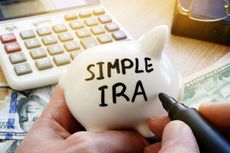A New Way to Move Into a Roth 401(k)
Soon you may be able to roll over your 401(k) or 403(b) to a Roth inside your employer plan.

If you have been wishing you could convert some or all of your retirement savings to a Roth IRA -- and enjoy tax-free withdrawals in retirement -- but your money is tied up in your employer’s plan, you may be in luck. A new law allows participants in employer-provided 401(k) and 403(b) plans to roll over their savings to a Roth 401(k) account within their plan. You don’t have to cash out your investments; you can simply transfer your assets to the new account within your plan. But employers must amend their plans to allow the transfer, and they are not required to do so. Even if your employer amends its plan to allow Roth conversions, the amount you can transfer may be restricted. Only those workers who are 59½ or older can convert all of their traditional 401(k) or 403(b) plan to a Roth. Younger employees can convert only employer contributions; they cannot convert their own employee contributions. You have to pay income taxes on the entire amount you convert (except for any after-tax contributions).
The same law authorizes 457 retirement plans, used by state- and local-government workers, to start offering a Roth option next year.
Figuring the tax bill. If you have both before-tax contributions (the most common type) and after-tax contributions (unusual, but possible) in your retirement account, you would pay tax only on the portion that represents your pretax contributions. But you can’t separate out the contributions and convert only the after-tax money. Say you have a $50,000 balance in your 401(k) plan and $10,000 came from after-tax contributions; you would have to pay taxes on four-fifths, or 80%, of any amount you convert.

Sign up for Kiplinger’s Free E-Newsletters
Profit and prosper with the best of expert advice on investing, taxes, retirement, personal finance and more - straight to your e-mail.
Profit and prosper with the best of expert advice - straight to your e-mail.
If your employer adopts the new provision by year-end, you could take advantage of a one-time option that allows taxpayers to spread the tax bill over two years. If you convert to a Roth this year, you may report half of the amount on your 2011 tax return, due in April 2012, and the balance on your 2012 return, due in 2013, paying taxes at whatever rates are in effect at that time. Or you could pay all of the tax on your 2010 return, which may be an attractive alternative for higher earners who fear that their tax rates will rise next year if the Bush-era tax cuts expire. But you don’t have to decide until you file your taxes in April, and by then, it should be clear which tax rates will apply.
Caveat: Unlike a Roth IRA conversion, which you may undo if the account value declines, a switch to a Roth 401(k) cannot be reversed.

-
 What Happens Financially When You Work One More Year?
What Happens Financially When You Work One More Year?The impact of saving more, spending less later and benefiting from an extra year or more of compounding can be truly staggering.
By Andrew Rosen, CFP®, CEP Published
-
 Seven Ways to Spend Your Tax Refund
Seven Ways to Spend Your Tax RefundYou may want to splurge, but using your tax refund to save for the future or pay down debt is a much better idea — even if not as fun.
By Kathryn Pomroy Published
-
 403(b) Contribution Limits for 2024
403(b) Contribution Limits for 2024retirement plans Teachers and nonprofit workers can contribute more to a 403(b) retirement plan in 2024 than they could in 2023.
By Jackie Stewart Published
-
 SEP IRA Contribution Limits for 2024
SEP IRA Contribution Limits for 2024SEP IRA A good option for small business owners, SEP IRAs allow individual annual contributions of as much as $69,000 a year.
By Jackie Stewart Published
-
 Roth IRA Contribution Limits for 2024
Roth IRA Contribution Limits for 2024Roth IRAs Roth IRA contribution limits have gone up for 2024. Here's what you need to know.
By Jackie Stewart Published
-
 SIMPLE IRA Contribution Limits for 2024
SIMPLE IRA Contribution Limits for 2024simple IRA The maximum amount workers at small businesses can contribute to a SIMPLE IRA increased by $500 for 2024.
By Jackie Stewart Published
-
 457 Contribution Limits for 2024
457 Contribution Limits for 2024retirement plans State and local government workers can contribute more to their 457 plans in 2024 than in 2023.
By Jackie Stewart Published
-
 Roth 401(k) Contribution Limits for 2024
Roth 401(k) Contribution Limits for 2024retirement plans The Roth 401(k) contribution limit for 2024 is increasing, and workers who are 50 and older can save even more.
By Jackie Stewart Published
-
 Is a Medicare Advantage Plan Right for You?
Is a Medicare Advantage Plan Right for You?Medicare Advantage plans can provide additional benefits beneficiaries can't get through original Medicare for no or a low monthly premium. But there are downsides to this insurance too.
By Jackie Stewart Published
-
 What You Must Know About the Different Parts of Medicare
What You Must Know About the Different Parts of MedicareMedicare Medicare can be complicated but we've got you covered. Here is a quick guide to the different benefits provided through each part.
By Jackie Stewart Last updated